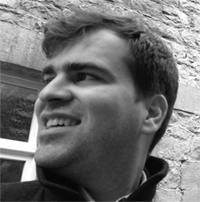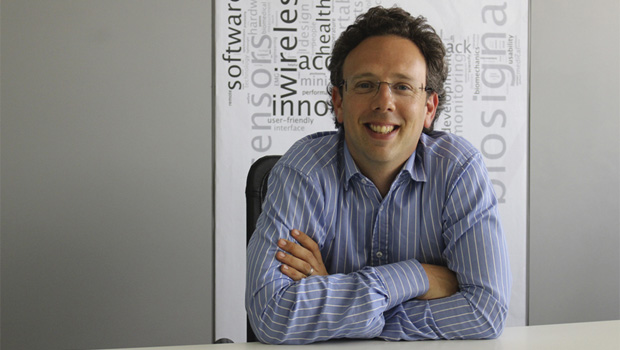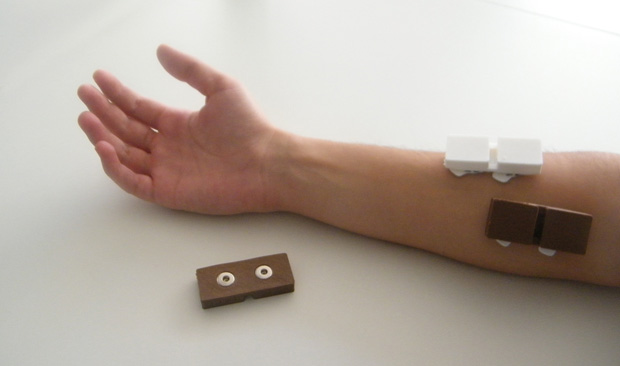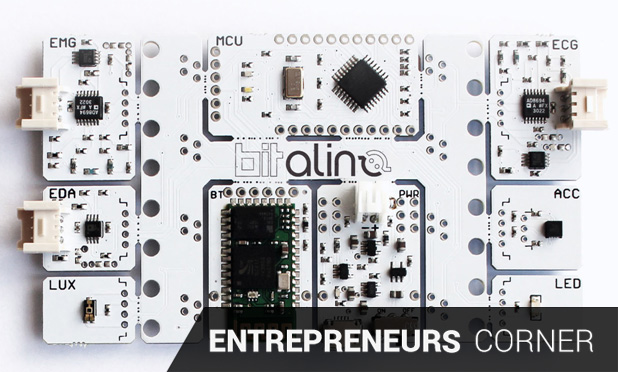Ahmed Morsy, Deputy EIC of IEEE Pulse, talks with Gregory Stern of PLUX about the challenges and rewards of bringing a low-cost innovative product to market
Poor signal to noise ratios, cross-talk, complex characteristics of body tissue, and signal variability are some of the known challenges facing researchers working with physiological signals. But students often face another fundamental challenge: cost! Most biosignal acquisition systems in the market have price points way out of reach for most students. Plux-Wireless Biosignals, a start-up based in Lisbon, Portugal, realized this market gap and acted on it. Pulse Deputy Editor-in-Chief, Ahmed Morsy, had the chance to speak to Gregory Stern, CEO of PLUX – Wireless Biosignals, the makers of BITalino.
Morsy: First off, tell me about the founding vision of Plux. What were some of the launch challenges?

Chief Innovation Officer of PLUX.
Stern: BITalino was born out of necessity, while Hugo Plácido da Silva, a founder and Chief Innovation Officer of PLUX (see right image) was working on his Ph.D. at the IT, the Instituto de Telecomunicações in Lisbon. To pursue his objectives while doing research on the use of biosignals for biometrics, there was a recurring need for biomedical devices prototyping. But as many other students can recognize, budget constraints are very limiting and low-cost hardware prior to BITalino offered limited performance for biomedical applications.
It was in this context that BITalino has been born: a modular, low-cost hardware and software toolkit for biomedical engineering, with all the essential building blocks for biosignal acquisition. The hardware includes sensors for electromyography (EMG), electrocardiography (ECG), electrodermal activity (EDA), accelerometry, and ambient light; it also has an on-board microcontroller unit (MCU), Bluetooth, power management, and a LED for visual feedback. The software includes apps, programming APIs, and all the tools needed for a student to learn, prototype, and develop entry-level research.
We then successfully negotiated a technology transfer agreement with IT to bring this concept and initial prototype to PLUX, where we took advantage of our professional multi-disciplinary engineering, production, and business development team. The lean startup methodology was used to test the business problem hypothesis, solution, pricing and messaging. We quickly realized that in fact there was a large niche to be addressed and this fit well into our overall research product portfolio.
Through this effort, our objective is to achieve with BITalino within the biomedical engineering and biosignals research community, what the Arduino has achieved in other disciplines.

Morsy: What was your initial source of funding?
Stern: Within PLUX initially we bootstrapped the investment for BITalino off of PLUX’s other sales from our biosignalsplux product line for advanced biomedical research, and physioplux (a biofeedback system for physical therapy rehabilitation). After the first year on the market and listening to our rapidly-growing user base, we understood several improvements that needed to be made and launched a Kickstarter campaign to fund our next generation version… the BITalino (r)evolution.
Through Kickstarter, we were able to reach another broader audience than the traditional biosignals community (e.g., makers, artists), though we set a minimal goal perhaps too high to be realistic. Nonetheless, we managed to convert a high percentage of our Kickstarter backers into BITalino (r)evolution pre-orders on our web store. These pre-order sales, in addition to a Horizon 2020 European Commission grant called RAPID-MIX, have helped us cover the costs of building new functionalities such as EEG and Bluetooth Low-Energy to enable iPhone apps. These pre-orders are being fulfilled in September and October 2015 and we expect to launch the revolution in time for Christmas and holiday purchases.
Morsy: When you launched the first product, what was the reaction of the market?
Stern: We were amazed by the breadth of press-coverage and diversity of customers, which ranged from individual students and makers to academia and industry leaders such as MIT or Boeing. This allowed us to quickly sell our initial few hundred units. Over time, makers, students, and professors within the BITalino community began sharing their projects and how they use BITalino, ranging from teaching applied psychology classes at the University of Florida to using BITalino to control an artistic installation in Barcelona. We were pleased to have reached close to 1000 users during 2014 (its first year), and to be now on target to more than double that number this year.
Morsy: Your focus on students and makers excludes professors and serious researchers. Are they included in your future strategy?
Stern: BITalino is actually also being used by professors and researchers alike seeking entry-level research tools on a budget. Nevertheless, PLUX does offer the biosignalsplux lineup, which has been specifically designed to address these more demanding needs. Biosignalsplux is composed of a generic data acquisition sensor hub with up to 8 channels, 18+ high performance sensor options, much better signal-noise ratio, higher sampling resolution, internal memory, and many other features that allow a researcher to get out of the lab and collect reliable high-performance data with a wearable system.

Morsy: What are your plans to take the company from the initial success phase into a growth phase?
Stern: Our vision for PLUX is to continue to innovate and provide a range of biosignal toolkit solutions that can open biosignals to the world, spanning students, professors, hobbyists, makers, developers, and original equipment manufacturers (OEMs). We’ve worked hard to offer leading customer service and high quality products at affordable prices, an effort that is also allowing us to reach professional wearable companies and OEMS with the innovation and reliability they demand. We expect our growth to come from offering biomedical hardware and software development services to OEMs, and from building compelling biosignal applications that use our toolkits.
In our new services offering, our unique advantage is the fact that we can speed time to market, and provide innovative sensors and embedded algorithms incorporating machine learning for OEMs that want to build next-generation wearables or reference designs. A good example of this would be our efforts together with Intel in creating gestureplux—an OEM reference hardware design that uses EMG from the wrist to extract gesture movements including clench, stop, or cut—as a differentiated input modality to the wearable market.
Physioplux is another example of a compelling application where we are currently nearing closure of a Series-A round to spin-off to its own company. We have impressive clinical evidence showing a 50% faster treatment of shoulder disorders for patients in physical therapy and a 90% reduction of patient relapses while using our medical device to assess, guide, and treat throughout the motor relearning process. Our initial sales market was in the Netherlands and we expect with the next funding round to have a much larger randomized control trial and be amongst the first generation of prescribed applications to treat pathologies in the United States and Europe.
Morsy: You are based in Portugal. Can you share with me some of the advantages and challenges of having a technology startup in Portugal?
Stern: Besides the beaches, good food, and wine, Lisbon and Portugal actually have some of the top technical universities in Europe, and currently there are not enough employers creating innovative products to employ this talent pool. In practice, this means that PLUX can attract very talented engineers while maintaining a competitive overall cost structure versus our competition in northern European countries or the United States.
In addition to the talent, Portugal itself is currently gearing towards startups, innovation, and grant funding. PLUX has received over €2 million in Portugal and European grant money since its founding in 2007. Also, we have received an initial seed round of investment for our physical therapy product in Portugal from Caixa Capital. Caixa Capital is trying to lead other investors in Europe to do cross-border investments beyond seed rounds, but it has been an uphill battle to make these proposed transactions a reality.
Another challenge is that in fact, the Portuguese economy has had some tough years through the crisis. Unlike some Silicon Valley based companies, we have had to learn quickly how to effectively focus all of our marketing and sales internationally for each of our products and services.
Morsy: Is there a mistake that you can admit making along the way? And how do you think you could avoid it if you went back in time?
Stern: How many pages do you have for this interview? Seriously, one of the hardest challenges is learning when to stay focused on your current strategy and when it is time to pivot to other higher growth potentials.
I would say that the founders of PLUX, who came from academia , should be commended for recognizing some of the mistakes they have made and realize that they needed some new management to help lead them into international expansion and towards a growth phase.
Morsy: What is your advice to future entrepreneurs with regard to starting up a company?
Stern: Solving a real and meaningful problem that you have validated is essential. Found it with a team rooted in deep bonds of trust that has complementary and necessary founding knowledge, from technical to business development.
Also, do not buy into the traditional Silicon Valley culture that says you have to work 80 hour weeks to win. At Plux, we have proven that you can build a family-oriented business while developing innovative products and technology at the same time. As an American CEO in Portugal, I have come to deeply treasure doing a startup while also having a balanced family life and taking four weeks of vacation a year and paternity leave, which ultimately allows us to have perspective to create a better product offering.



